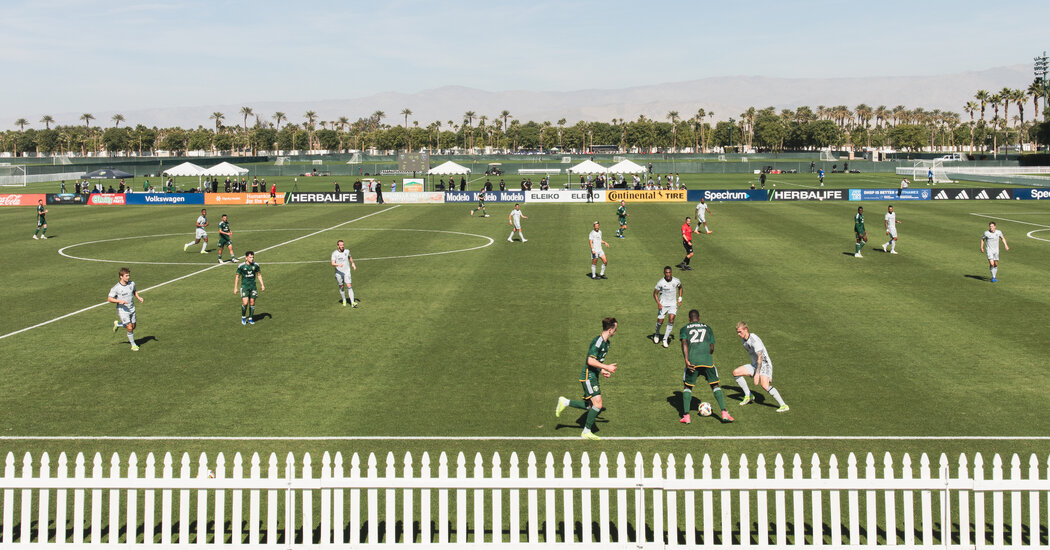On a recent Wednesday afternoon, Dan Perkin and Scott Bissmeyer, work buddies on vacation, sat on metal bleachers watching the Portland Timbers play the San Jose Earthquakes in the first of four preseason Major League Soccer games that day.
They had spent $125 each on V.I.P. day passes, which included food, drink and access to tents to keep cool. Self-described “M.L.S. road trippers,” they have visited numerous M.L.S. stadiums, and have watched teams in Tucson, Ariz., where as many as 11 clubs came together for preseason training in the past.
But this year, with 12 M.L.S. teams — along with two from the United Soccer League and four from the National Women’s Soccer League — gathered at a 1,000-acre property outside Palm Springs, Calif., for preseason training, Mr. Perkin and Mr. Bissmeyer decided to check it out.
“Compared to Tucson, they put on a nice operation here,” Mr. Perkin said of the site, the Empire Polo Club, best known as the annual site of the Coachella Music Festival. “If you’re going to drive six hours, we might as well treat ourselves.”
M.L.S. — and, more specifically, the entertainment conglomerate AEG, which owns the L.A. Galaxy, one of the league’s 10 original franchises — is hoping more fans start thinking like Mr. Perkin and Mr. Bissmeyer.
Pro sports leagues have for years tried to make money off their preseasons by marketing them to fans who want an up-close look at their team in a casual — and less expensive — setting. Major League Baseball has its spring training in Florida and Arizona, complete with exclusive jerseys and caps. National Football League teams open practices to fans during their training camps each summer. The National Basketball Association holds its Summer League in Las Vegas.
But during its 30-year history, M.L.S. had not had many large-scale training camps marketed to fans. The league experimented with the concept in the late 1990s, but the effort fell apart. Teams in warm-weather states prefer to stay home while other teams fly to Sun Belt states to train. Some teams prefer to travel to Spain, Mexico and beyond to prepare for the season. This month, Inter Miami flew to Asia and Saudi Arabia to showcase Lionel Messi, though an exhibition game in Hong Kong went awry when the Argentine star didn’t play.
In late 2021, however, Dan Beckerman, chief executive of AEG, had an idea. What if the Empire Polo Club could be repurposed to host M.L.S. teams in February, a relatively quiet part of the calendar? Mr. Beckerman thought AEG could marshal its subsidiaries to sell sponsorships, tickets, merchandise and food to give the event the feel of baseball’s spring training, where fans are able to see a number of teams playing close to one another.
“I wondered if we could create something like the Cactus League with some meaningful competition and quality fields,” Mr. Beckerman said, referring to baseball’s spring training in and around Phoenix. “But I had no idea if it could work.”
Mr. Beckerman said cold-weather soccer clubs had for years asked the Galaxy if they could train at their facilities in Carson, Calif. But with only eight fields, there was never enough space. So despite the potential awkwardness of one M.L.S. team’s making money off its rivals, Mr. Beckerman asked Tom Braun, the Galaxy’s president of business operations, if the polo club, much of it lush Bermuda grass lawns, could be used.
Mr. Braun had a commitment from six teams before he discovered that many of the fields had divots from the polo horses and concert festivals. The Galaxy’s head groundskeeper, Shaun Ilten, patched together enough fields in time for the inaugural training camp in 2022 that, because of Covid restrictions, did not have fans.
The teams were pleased, and last year a dozen clubs showed up and AEG sold tickets and sponsorships. This year, the Coachella Valley Invitational, as it’s known, had 18 teams. Food trucks and exclusive merchandise like bucket hats and team decals were added. Attendance was expected to grow about 40 percent, to about 30,000 fans over the seven match days. The invitational ends on Saturday, with the N.S.W.L. teams playing; the M.L.S. season began this week.
“This is our version of thinking out of the box,” Mr. Braun said. “Our hope is to get teams to commit to this for the long term.”
Preseason games don’t count toward the standings, but they are essential to coaches, who need to evaluate their players, and doing that on high-quality fields is critical to preventing injuries. AEG promises teams two dedicated practice fields each and access to four- and five-star hotels with at least 40,000 square feet for meetings, training rooms and equipment. The teams pay their way to California and for the hotels, as well as for what Mr. Braun called a “reasonable” rental fee for the fields.
There are no locker rooms, so players come to the polo club dressed in their soccer gear. Each team is assigned a dedicated groundskeeper to meet the requests of each coach. AEG provides goals, tents and other equipment, and it spent about $2 million renting high-end gear for a makeshift gym.
“We’re certainly in the business of making money, but we want this to run efficiently,” Mr. Braun said, adding that the event was a “long-term build, but I wouldn’t put it past being a moneymaker in the short term.”
Still, he said, it won’t succeed unless the teams are happy.
“You look at the backdrop, the pitches, it’s perfect,” said Phil Neville, the coach of the Timbers. “We’re traveling 11 months of the year, so we don’t need more air travel on top of that.”
Mr. Neville and other coaches liked working with the players in semi-isolation. It allows their teams to bond over dinner, rounds of golf or games of the tabletop soccer hybrid known as teqball. The addition of fans, as well as small scoreboards and announcers, also helped give the games a more authentic feel.
“It’s definitely more organized this year, where we get here and play,” said Keaton Parks, a midfielder on New York City F.C. “Last year, it felt more like a youth tour where we sat around awhile waiting to play.”
Mr. Parks and other players trained in a country-club atmosphere. One of the two game fields abutted a rose garden with a large fountain amid palm trees and snow-capped mountains in the distance. The Tack Room Tavern, a stone’s throw from the fields, had a menu that included the “Saddle Up Breakfast” and Peach Bellinis.
White picket fences served as borders around the field and trainers’ tables stood on the sidelines. As games finished, players crossed paths with the next teams, often stopping to hug friends and former teammates. Fans with Sharpies, shirts and soccer balls asked for autographs and posed for selfies.
Based on the reaction of many fans, the experiment is off to a good start. Maria De Luca, who lives in Toronto, was sitting with her sons, Emi, 10, and Mati, 11, watching Minnesota United play Chicago Fire F.C. She thought paying $25 for a day pass was a bargain, and it allowed the soccer-loving boys, who both wore Messi Argentina shirts, to meet the players and see the game up close. She said they would return next year because her husband attended an annual conference in Palm Springs.
“Soccer is like everything to these guys,” she said, pointing to her boys. “I think this can get big.”

